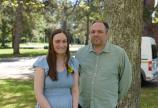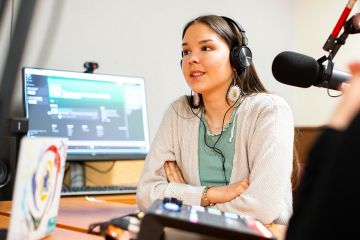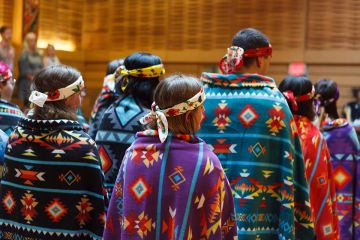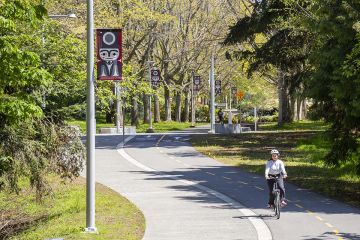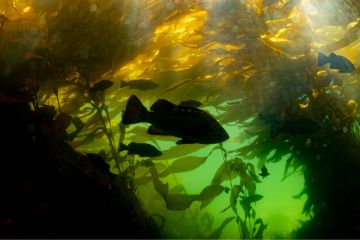Ojibwe language spirit on ləkʷəŋən land
- Michelle Butterfield
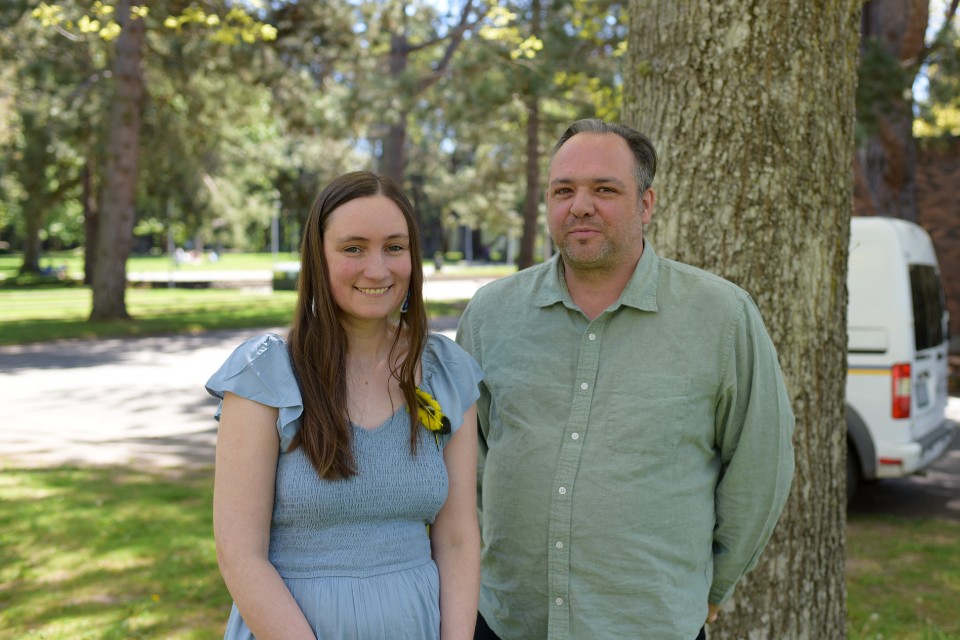
Graduate student’s comprehensive needs assessment to support urban Ojibwe people in reclaiming language and culture whether near or far from homelands
For years, when introducing herself, Wiigwaas would say "gaawiin gegoo ngikendaansii" which means, "I know nothing" in Anishinaabemowin (the Ojibwe language). Now, with prompting from an Elder, Aldeen Mason, she corrects herself and says "bangii eta go ngikendan," which means, “I know a little bit."
She has just completed the Master of Education in Indigenous Language Revitalization program under the supervision of Jean-Paul Restoule in Indigenous Education and Li-Shih Huang in Linguistics. Her thesis “Ozaaweshiinh ləkʷəŋən-Aking: Ojibwe Language Spirit on ləkʷəŋən Land” explored the language learning needs, barriers and responsibilities of the Ojibwe (Anishinaabe) community living in ləkʷəŋən and W̱SÁNEĆ territories.
The big move
Wiigwaas grew up in the small farming community of Roseneath on Rice Lake. She is Anishinaabe and Irish on her dad’s side and a member of Hiawatha First Nation and Crane Clan. On her mom’s side, she has German and Irish ancestry. Growing up, she often visited the nearby community of Hiawatha. Still, she never got to live there due to the impacts of the Indian Act, and she recalls her parents seeking better economic circumstances outside of Roseneath. One day, her mom received a job offer from a friend in qathet (formerly called Powell River), to run a community living facility. In the year 2000, when Wiigwaas was 11, her family made the big move west to qathet.
I think [the move] was hardest for my grandparents and my sister. At that age it was hard, and we didn't get to go back very often. My dad's three siblings still live in Ontario, too. I've missed out on building as strong of a relationship as I could have with them. It’s difficult being urban and being so far away from your territory.”
—Wiigwaas Carmen Craig
Connecting with heritage
Wiigwaas says it was surprising to walk into a room full of her cousins at First Peoples House on campus at UVic. The university sits 4,000 kilometres away from her home territory. There, she met Estrella Whetung, a cousin with a deep knowledge of their family tree. “She introduced me to tons of my relatives out here. There are relatives I have through shared ancestors and those I have through treaties. Those connections have been important for me.”
Through Estrella’s knowledge, Wiigwaas could look back many generations into her family tree. “I’m interested in knowing who my ancestors are because it connects me to so many people who are alive right now.”
Learning the language
The last Ojibwe speaker in Wiigwaas’ family was her great-grandmother, whose generation kept the language from their children due to concerns about repercussions at school. Wiigwaas’ main early exposure to Ojibwe language learning was at Roseneath Centennial Elementary School. “We had a bunch of amazing teachers from kindergarten to grade five. Mr. Knott was one of them, he would jump and shake the portable and make us laugh. We did circle every day, or at least once a week. We’d get to introduce ourselves in our language and we all got to pick a stuffed animal and introduce them.”
Another influential person in Wiigwaas’ life is Cathi Charles Weary, an Anishinaabe person from Rama First Nation. “I only met Cathi a few years ago. She went to high school with my parents. My mom had a close relationship with Cathi’s uncle, George ‘Gung’ Charles, and learned from him.”
Through the teaching of Uncle Gung, Wiigwaas’ mom understood how important it was for her daughters to stay connected to their language and culture. She made sure they attended language and culture classes and regularly took them to community events to build early connections to their culture.
Cathi now attends Wiigwaas’ weekly language classes. “In large part, it’s because of her uncle that I’ve been able to learn what I know and now I’m giving the knowledge back to her. It's just been a really amazing relationship. She has become like family to me.”
Wiigwaas says her dad has a more complex relationship with learning the language: “I've caught him looking through my language books before, so I think he wants to learn, but I don’t think he believes he could do it. I'm the first person on that side of my family to finish high school.”
An academic pathway
After high school, Wiigwaas started a diploma program in creative writing at Camosun College. There, she took French courses and enjoyed the experience of communicating for the first time in a second language. It got her thinking: Why had she picked up French with relative ease within a year, when she still couldn’t put together a sentence in Nishnaabemwin despite having focused on it for so long? She got the idea that linguistics may be the place to answer that question.
In 2013, Wiigwaas enrolled in the Bachelor of Arts in Linguistics program at UVic with a focus on language revitalization. She wanted to understand the different contexts of learning a heritage endangered language, like Ojibwe, compared to non-heritage, non-endangered languages. She took on undergraduate research in this area under the supervision of Dr. Li-Shih Huang and began attending Language Table, a weekly conversation space held at UVic. In 2020, Wiigwaas entered the Master of Education in Indigenous Language Revitalization program.
I wanted to look at what Anishinaabe people who are living on ləkʷəŋən and W̱SÁNEĆ territories need to repair their relationship to our language and culture if it needed repairing. My main goal was to learn about what's needed and what's wanted.”
—Wiigwaas Carmen Craig
Outstanding graduate student research
For her master’s project, Wiigwaas undertook a comprehensive study that examined the needs and barriers of Anishinaabemowin learners residing on ləkʷəŋən territory. She designed a survey that collected data on who local Anishinaabemowin learners are and how they prefer to learn language and culture. The survey also asked about their experiences of both struggle and support in accessing language and culture while living in Victoria. She then invited survey respondents to participate in talking circles to share their experiences in greater depth.
I felt I had to do a survey, because I wanted to include everybody who wanted to participate, but I also wanted to do a circle because I wanted to go deep into the topic, and a survey isn't a good place to go deep. I had a circle with six participants, and with me sitting in the circle it became seven people. Seven is a really significant number to Anishinaabe people.”
—Wiigwaas Carmen Craig
Wiigwaas’ project highlights the significance of language as a repository of traditional knowledge, cultural practices and spiritual beliefs. Her thesis now serves as a practical resource for Indigenous language revitalization initiatives, community-based language programs and educational curricula.
By centring Indigenous voices, perspectives and methodologies, it offers strategies for language reclamation, community empowerment and decolonization. It examines the impacts of linguistic assimilation policies and cultural displacement on Indigenous languages. Through this lens, Wiigwaas has shed light on the determination of Indigenous peoples to reclaim and celebrate their languages as integral components of cultural identity and sovereignty.
She has recently been recognized for this work by the UVic Faculty of Education as a recipient of a 2024 Outstanding Graduate Student Research Award.
Wiigwaas’ work represents a significant contribution to the fields of Indigenous education and Indigenous language revitalization. It exemplifies her dedication to advancing Indigenous knowledge systems, fostering intercultural understanding and promoting social justice.”
—Jean-Paul Restoule, Indigenous Education program chair
On the go
Wiigwaas now co-supports an Anishinaabe Language Table at the Victoria Native Friendship Centre with her relatives Janice Simcoe and Zophia Rakowski. She's continued teaching weekly language classes that focused on fluency and grammar.
Recently, she and her cousin Estrella started Oodenaw: Urban Indigenous Consulting Cooperative, an Indigenous-led consulting co-op offering services like curriculum and workshop development, Indigenous engagement training and leadership training. Both had worked in consulting firms under non-Indigenous leadership and experienced cultural and values misalignment. “We wanted to develop our own policies that align with our values and allow us to care for our communities and each other.” The team has already completed several projects and presented in Ottawa and Saskatoon, but say they are still in the early stages of building the co-op.
When asked about what people can do to further Indigenous Language Revitalization, Wiigwaas says everyone at UVic should be learning at least basic SENĆOŦEN and lək̓ʷəŋən, like place names and greetings, and using the phrases in daily life. She says it’s also important for people to learn more about the experience of urban Indigenous people across Turtle Island.
Around 80 per cent of Indigenous people in Canada live off reserve, and we’re an extremely under-served population in terms of access to the rights we have inherently, or that were agreed to. It’s not something people know much about or talk about nearly enough.”
—Wiigwaas Carmen Craig
Photos
In this story
Keywords: student life, education, Indigenous, community

